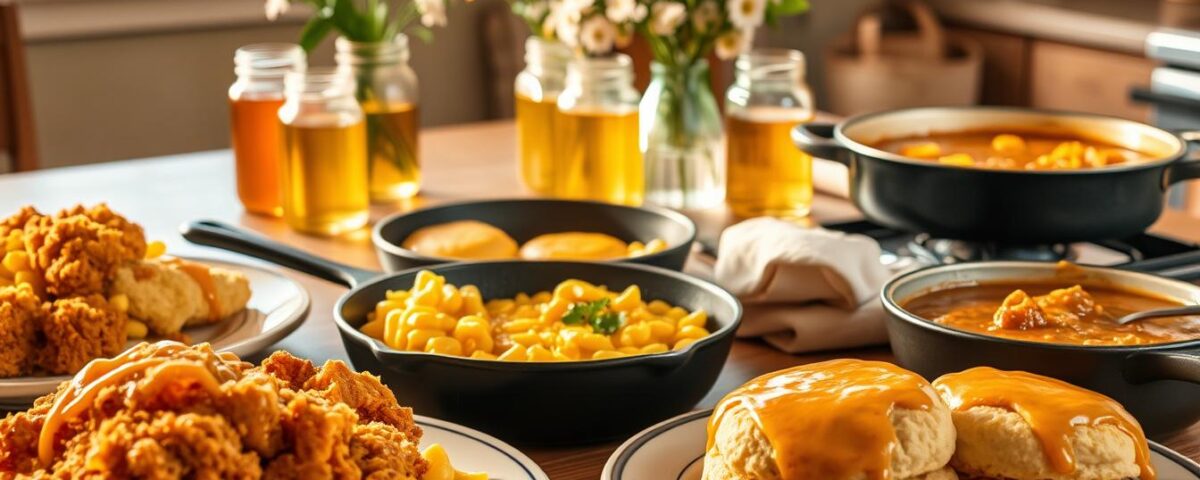
How to Recreate Classic Diner Meals from the 1950s at Home
June 4, 2025
What to Eat in Istanbul Before You Leave the City
June 4, 2025Did you know 83% of Americans associate at least one meal with childhood memories of family gatherings? I learned this truth firsthand while standing in my grandma’s kitchen, watching her fold buttermilk into biscuit dough like it was a sacred ritual. The smell alone could melt away stress faster than a summer storm clears the air.
Those biscuits weren’t just food—they were edible love letters. That’s what these dishes do: wrap you in familiarity while surprising your taste buds. I’ve spent years collecting recipes that balance tradition with fresh ideas, like adding smoked paprika to collard greens or swapping lard for browned butter in pie crusts.
This list isn’t about complicated techniques. It’s about heartfelt meals that turn kitchens into gathering spaces. Whether you’re reviving family traditions or starting new ones, each recipe here carries the warmth of shared stories and second helpings.
Key Takeaways
- Discover dishes blending time-honored flavors with creative updates
- Learn how simple ingredients create deeply satisfying meals
- Explore my personal favorites from a lifetime of tastetesting
- Gain practical tips for perfecting textures and presentations
- Find meals that transform ordinary evenings into cherished moments
Introduction to Southern comfort food recipes
Cooking these dishes feels like dialing a direct line to my childhood. My grandmother’s handwritten notes in her cookbook show where she tweaked spice blends over decades. Those stained pages hold more than ingredients—they preserve laughter around Sunday supper tables and the quiet pride of perfecting a classic.
Why These Meals Feel Like Home
Three elements make this regional cuisine unforgettable:
- Stories simmered into every pot of beans
- Affordable staples transformed through patience
- Techniques polished across generations
Take fried chicken. My great-uncle brined his in sweet tea before dredging—a trick from the 1940s. Today, I add cayenne to the mix. That’s the magic: honoring roots while letting recipes breathe.
What surprises newcomers? How humble components shine. Smoked ham hocks turn bitter greens velvety. Leftover cornbread becomes breakfast pudding. Even simple chicken and dumplings gain depth from bone broth made with vegetable scraps.
Modern twists keep traditions alive. Last fall, I swapped buttermilk for yogurt in my biscuit recipe—lighter texture, same soul. That’s how these dishes endure: adapting without losing their heartbeat.
A Cozy Journey Through Southern Flavors
My first bite of smoky collard greens taught me flavors could whisper secrets. That pot held generations of spice blends and Sunday afternoons spent stirring. Like fingerprints, every cook’s version tells its own story through pepper flakes or a splash of apple cider vinegar.
- Creamy: Whipped potatoes hugging gravy like old friends
- Crispy: Chicken skin crackling with peppery heat
- Velvety: Simmered beans melting into potlikker broth
At my aunt’s table, pies arrive with origin tales. “This crust? Your cousin swapped shortening for cold butter in ’92,” she’ll say. Meals here aren’t eaten—they’re experienced, layered with memories and innovations.
What surprises me most? How paprika-dusted okra and honey-drenched cornbread coexist effortlessly. Boldness balances subtlety in every bite. Last Thanksgiving, my niece asked why the mac and cheese tasted “like hugs.” That’s the magic—these dishes speak a language everyone understands.
Through trial and triumph, I’ve learned great meals need three things: patience, quality ingredients, and someone to share them with. The real secret ingredient? Stories passed down like heirloom silverware.
Exploring Bold Fried Chicken Classics
The crackle of golden crust giving way to juicy meat sends taste buds into overdrive. My neighbor Mrs. Wilkins once told me, “Good fried chicken isn’t cooked—it’s engineered,” while showing me her dented cast-iron skillet. That’s when I realized every crispy bite holds science and soul.
Crispy Coatings and Flavorful Marinades
True magic starts hours before frying. A buttermilk bath with garlic and smoked paprika tenderizes while building flavor depth. For extra crunch, I mix crushed cornflakes into my flour blend—a trick from a Nashville chef’s secret recipe.
Double-dredging makes coatings stick. Dip chicken in seasoned flour, then egg wash, then flour again. Let it rest 10 minutes so the crust adheres. This creates layers that sizzle into textured perfection.
Secrets to Achieving the Perfect Crunch
Oil temperature is non-negotiable. Use a thermometer to maintain 350°F—too hot burns the crust, too cool makes grease seep in. Fry in batches to prevent crowding, which causes sogginess.
My aha moment came when I started resting fried chicken on a wire rack instead of paper towels. Air circulation keeps the bottom crust crisp while the meat stays moist. Serve with zesty comeback sauce or spicy honey for dipping fireworks.
Last week, a friend asked why my version stays crunchy for hours. “It’s all in the double-dredge and patience,” I winked. Now you’ve got the blueprint to make that magic your own.
Buttermilk Biscuits: Flaky and Golden Goodness
Nothing signals morning in my kitchen like the thunk-thunk of a biscuit cutter piercing dough. My grandmother’s rolling pin still bears flour stains from decades of shaping these golden treasures. “Biscuits aren’t made—they’re felt,” she’d say while folding layers into existence.
Time-Tested Techniques
Buttermilk works magic here. Its acidity reacts with baking soda, creating air pockets that yield tender crumbs. Cold butter is non-negotiable—slice it into pea-sized bits before mixing. Handle the dough like a fragile letter; overworking makes biscuits tough.
Here’s my failproof method:
- Whisk dry ingredients in a wide-mouth pot for even mixing
- Cut butter into flour until it resembles coarse sand
- Pour buttermilk in slowly, stirring just until clumps form
Bake in a preheated cast-iron skillet—the radiant heat creates crisp bottoms. Watch them rise like proud little clouds. Pair with jam for breakfast or smother with sausage gravy at supper. Last week, I served them alongside spicy collards, and the combo vanished faster than fireflies at dawn.
My secret? Freeze grated butter before blending. This keeps fats solid longer, ensuring flakiness. Whether you’re new to baking or a seasoned pro, mastering these golden wonders turns any meal into a celebration. Trust me—your kitchen will smell like victory.
Decadent Pies That Warm the Soul
The scent of caramelized sugar and toasted nuts wafting from the oven instantly transports me to my aunt’s farmhouse. Pies here aren’t mere desserts—they’re edible history books. Each slice carries whispers of church potlucks, harvest celebrations, and midnight conversations over cooling racks.
Pecan Pie Perfection
Getting that pecan pie balance right feels like solving a delicious equation. Too sweet? Add bourbon. Too flat? Toast the nuts first. My cousin’s secret? A pinch of flaky salt on top—it makes the maple sing while taming the syrup’s intensity.
Crunchy pecans float in a custard that’s neither jiggly nor stiff. The trick? Bake at 375°F until the center barely wobbles. Let it set overnight. Serve with coffee so bitter it makes your eyebrows dance—that contrast is pure magic.
Sweet Potato Pie Delights
Roasting sweet potatoes whole transforms their flavor. The flesh caramelizes, creating a natural sweetness that outshines cinnamon or nutmeg. My grandma always said, “Good pie starts with patience—let the oven do the work.”
I blend mine smooth as satin, then spike it with orange zest. The crust? Cold butter and ice water create layers that shatter delicately. Last Thanksgiving, my nephew declared it “better than cake”—high praise from a frosting enthusiast.
These creations aren’t just treats. They’re edible heirlooms. Try swapping honey for corn syrup in your pecan pie, or add cardamom to sweet potato filling. Honor tradition, but make each bite your own. After all, the best recipes live in the spaces between “always” and “what if?”
Chicken Pot Pie with a Creative Twist
I discovered the power of reinvention during a snowed-in weekend when my pantry held only chicken, root vegetables, and determination. My twist? Replacing the traditional crust with fluffy chicken dumplings that steam atop the filling like edible clouds. The result? A hybrid wonder that’s part stew, part pie—all comfort.
Creamy Fillings and Buttery Biscuit Toppings
My filling starts with a rich gravy simmered from roasted bones—depth matters. I layer shredded meat with caramelized leeks and rainbow carrots. Last fall, I stirred in roasted garlic puree, which made the sauce velvety enough to coat a spoon.
Instead of a bottom crust, I drop dumpling dough directly into the bubbling pot. They puff up while absorbing savory juices below. For crunch, I top everything with thyme-scented biscuit crumbles. The contrast? Pure magic—tender meets crispy in every bite.
| Element | Traditional | My Version |
|---|---|---|
| Crust | Double pastry | Dumplings + biscuit crumble |
| Vegetables | Peas & carrots | Roasted parsnips & kale |
| Cooking Vessel | Pie dish | Cast iron skillet |
| Serving Style | Individual slices | Family-style scooping |
My first attempt overflowed the skillet, creating what my nephew called “volcano dinner.” Now I know: leave space for dumplings to rise. The beauty? You can adapt endlessly—swap turkey for chicken, add mushrooms, or stir in hot honey for kick.
This dish proves tradition thrives on evolution. Keep the soul—rich gravy, tender meat—but let your pantry guide the details. After all, the best meals aren’t made from rules, but from hungry creativity.
Innovative Takes on Classic Mac and Cheese
My mac and cheese awakening happened during a power outage. Candlelight revealed my recipe needed more personality than elbow noodles and orange powder. Now? It’s a flavor symphony starring three cheeses and a crunchy crown that’ll make your oven jealous.
Freshly grated cheese changes everything. Pre-shredded bags contain anti-caking agents that dull sauces. I blend sharp cheddar for tang, fontina for silkiness, and a whisper of smoked gouda. Melted slowly in cream, they create a sauce that clings to noodles like liquid velvet.
The magic finishes in a casserole dish. A topping of panko breadcrumbs mixed with grated parmesan bakes into golden armor. This crunch contrasts the creamy base beautifully. For extra depth, I stir roasted garlic into the sauce—it adds subtle sweetness without overpowering.
Want to wow picky eaters? Try these twists:
- Swap breadcrumbs for crushed pretzels or potato chips
- Add diced jalapeños and crispy bacon bits
- Layer in caramelized onions between cheese sauce
This reinvented comfort food balances nostalgia with excitement. Serve it straight from the oven when the topping crackles like autumn leaves. Leftovers? They don’t exist. My neighbor’s kids now request “the fancy mac” for birthdays—proof that even classic dishes can wear new clothes.
Fresh Collard Greens and Hearty Side Dishes
Sunlight filtering through collard leaves in my garden always sparks creativity. These sturdy greens form the backbone of memorable meals, their earthy bitterness mellowing into something magical when treated right. I’ve found they’re not just a side dish—they’re flavor canvases waiting for bold strokes.
Infusing Traditional Recipes with New Flavors
My grandmother simmered collard greens with smoked turkey for hours. Today, I add coconut milk and ginger during the last 20 minutes. The result? Silky leaves with a tropical whisper that pairs perfectly with spicy mains.
Potatoes get similar treatment. Instead of standard mash, I roast them with smoked paprika and garlic until edges caramelize. Tossed with chives and lemon zest, they become a side dish that steals the spotlight.
Balance matters. For every robust greens pot, I serve something bright—quick-pickled radishes or citrus-dressed slaw. This contrast keeps plates exciting without overwhelming palates.
Three tips for nutrient-rich collard greens:
- Remove stems first—they take longer to soften
- Add apple cider vinegar early to lock in vibrant color
- Cook just until tender to preserve vitamins
With potatoes, texture is key. Parboil before roasting for fluffy interiors. Mix in roasted garlic butter post-bake for aroma that lingers like good conversation.
Don’t fear experimentation. Last week, I tossed chopped collard greens into potato hash with cumin and coriander. My dinner guests scrapped their plates clean—proof that even humble sides can become headliners.
Soul-Satisfying Shrimp and Grits
The moment plump shrimp hit my sizzling skillet, their edges curling into caramelized perfection, I knew this dish was special. A warm bowl cradles creamy grits like liquid silk, topped with spice-kissed seafood that crackles with every bite. It’s more than dinner—it’s a edible embrace.

Spice Infusions and Creamy Textures
Balance makes this meal sing. I start grits with chicken broth and heavy cream, stirring constantly until they’re smoother than jazz. Sharp cheddar melts in last, creating a base that hugs each shrimp like they’re old friends. For heat, I rub the seafood with smoked paprika and cayenne—just enough to make your tongue tingle without overpowering.
My cousin once said, “Good grits should feel like a hug from your favorite sweater.” Here’s how I achieve that:
- Toast spices briefly to unlock hidden flavors
- Add a splash of lemon juice to cut through richness
- Simmer grits low and slow—no shortcuts
Last winter, I swapped traditional andouille sausage for chorizo. The smoky heat elevated the dish into soul-warming territory. Serve it with crusty bread to mop up every last drop. Want to try it? I’ll walk you through each step in my next guide—guaranteed to turn your kitchen into the coziest spot in town.
New Orleans Inspired Gumbo and More
The first time I tasted real New Orleans gumbo, the dark roux whispered stories of French Quarter kitchens and bayou fish camps. This soup isn’t just cooked—it’s curated, layer by layer, like a jazz band building to crescendo. My version balances smoky andouille sausage with tender chicken, creating a broth that hums with history.
Proteins anchor the magic here. Turkey necks add gelatinous richness, while chicken thighs stay juicy through hours of simmering. I learned from a Creole cookbook that the holy trinity—onions, celery, bell peppers—should sizzle until they sweat secrets. Okra thickens naturally, its earthiness cutting through the heat.
True depth comes from patience. A 45-minute roux, stirred like molten mahogany, forms the flavor foundation. “Gumbo waits for no one,” my friend Pierre once warned as I rushed the process. He was right—hurried batches taste flat, while slow-cooked versions sing with complexity.
This recipe adapts beautifully. Swap shrimp for sausage during Lent, or use smoked turkey when poultry’s scarce. Serve over rice with filé powder dusted on top. Last Mardi Gras, I stirred in roasted garlic and thyme from my garden—a twist that earned nods from Louisiana natives at our table.
More than a soup, gumbo embodies resilience. Born from West African, French, and Choctaw influences, it’s survived storms and scarcity. Your pot might lack crab or tasso ham, but it’ll still cradle hearts. I’ll share my flexible recipe next week—proof that great meals thrive on improvisation.
Mastering Rich Sauces and Gravy Techniques
The first time I whisked a roux to velvet perfection, I realized sauces aren’t toppings—they’re liquid alchemy. A great gravy can turn roasted carrots into a main event or make biscuits weep with joy. In my kitchen, these creations bridge memories and innovation.
From Sausage Gravy to Tangy BBQ Sauces
Let’s start with the king of breakfast tables: sausage gravy. The magic lies in rendering pork fat slowly—I let the meat sizzle until it whispers caramelized secrets. Sprinkle flour gradually, stirring until it smells like toasted nuts. Then, pour milk in thirds, letting each addition thicken before the next. “Good gravy needs patience, not muscle,” my neighbor advised as I learned this dance.
For BBQ sauce, balance is everything. Simmer ketchup with apple cider vinegar and molasses, then spike it with smoked paprika. My twist? A dash of cold brew coffee adds earthy depth without bitterness. Test it on roasted veggies before slathering on meats—you’ll taste the difference.
Tools matter. A heavy kitchen staple like a Dutch oven distributes heat evenly, preventing scorched bottoms. When making pan gravy, always deglaze with broth—those crispy bits hold flavor gold.
Three tips for silky results:
- Strain lumpy mixtures through a fine mesh sieve
- Finish with a pat of butter for glossy sheen
- Adjust salt after reducing—concentration changes everything
Regional southern recipes thrive on personal touches. Try adding sage to your next sausage gravy or smoked honey to BBQ blends. Master these foundations, and you’ll wield the power to transform Thursday leftovers into Friday feasts.
Balancing Tradition with Healthy Twists
I never thought I’d see the day when my aunt’s fried chicken recipe could lighten up without losing its crackle. But after her diabetes diagnosis, we tackled her cookbook like culinary detectives. Our mission? Keep the soul of classic dishes while trimming excess calories—no flavor compromises allowed.
Reducing Calories Without Sacrificing Flavor
Swapping ingredients became our superpower. Greek yogurt replaced mayo in potato salad, adding tang without the grease. Ground turkey sneaks into meatloaf so well, even my carnivore uncle asks for seconds. The secret? A splash of apple cider vinegar mimics pork’s richness.
Three rules guide our kitchen experiments:
- Fresh herbs over salt for vibrant flavor bursts
- Roasting veggies instead of frying for caramelized depth
- Using citrus zest to brighten rich sauces naturally
Last Thanksgiving proved these tweaks work. Our revamped pecan pie—maple syrup instead of corn syrup, almond flour crust—disappeared faster than the original. That’s the beauty: honoring favorite southern traditions while nourishing tomorrow’s memories. Your turn—which family recipe will you reinvent first?
Essential Kitchen Tools for Southern Cooking
The clang of my grandmother’s cast iron skillet hitting the stove still echoes in my cooking today. Her kitchen wasn’t fancy—just a few trusty tools that turned simple meals into masterpieces. I’ve learned that the right equipment shapes flavors as much as fresh ingredients do.
Cast Iron, Dutch Ovens, and More
Heavy pans anchor this cuisine. My seasoned skillet fries chicken to crackling perfection and bakes cornbread with golden edges. Dutch ovens? They’re workhorses for slow-simmered stews and bubbling cheese grits. Their even heat distribution prevents scorching—a lifesaver for busy cooks.
Three tools I’ll never replace:
- Cast iron skillet: Develops crispy textures you can’t achieve with nonstick pans
- Enameled Dutch oven: Perfect for acidic dishes like tomato-based gumbos
- Biscuit cutter: Creates flaky layers by sealing dough edges quickly
| Tool | Best For | Pro Tip |
|---|---|---|
| Cast Iron | Frying, baking | Season monthly with flaxseed oil |
| Dutch Oven | Stews, braises | Deglaze with broth to lift flavor bits |
| Wooden Spoon | Stirring sauces | Soak in oil to prevent cracking |
Maintenance matters. I scrub my skillet with coarse salt, never soap. For Dutch ovens, baking soda paste removes stubborn stains. These pieces last generations if cared for—my niece uses my great-aunt’s skillet weekly.
Want to elevate your kitchen game? Invest in heavy-bottomed pots and seasoned iron. They’ll transform weeknight dinners into heritage-worthy meals. Trust me—your taste buds will thank you.
Tips for Perfect Presentation and Family-Style Serving
Steam rising from a cast iron skillet carries more than aroma—it’s an invitation. A table draped in checkered cloth becomes a stage where memories simmer. My mentor once said, “Food tastes better when eyes feast first,” and I’ve lived by that truth ever since.
Mismatched ceramic platters add charm to family gatherings. Serve fried okra in wide bowls so crispy bits stay audible. For gravy-smothered biscuits, use shallow dishes that let golden edges peek through sauce rivers. Every dish should whisper, “Come gather.”
Fresh rosemary sprigs or pickled veggies brighten plates without fuss. At breakfast, nestle sausage links beside grits in individual ramekins—the contrast warms hearts before forks lift. For dinners, stack cornbread slices vertically like edible towers.
Coordinate colors like a painter. Pair emerald collard greens with burnt orange sweet potatoes on creamy white stoneware. Let cranberry-stained recipes shine against slate boards. Remember: textures matter as much as hues. A rough-hewn wooden bowl makes silky beans feel grounded.
Casual meals thrive on accessible abundance. Place serving spoons in every dish, encouraging hands to dive in. For parties, label quirky toppings in chalkboard pots—“Paprika Dust” for deviled eggs or “Honey Lightning” for fried green tomatoes. The goal? Make every guest feel like they’re pulling up to their grandma’s table—where comfort lives in both flavor and fellowship.
My Personal Journey with Southern Comfort Dishes
The hum of our window AC unit harmonized with my grandmother’s biscuit cutter like a summer symphony. At six years old, I’d perch on a flour-dusted stool, watching her hands transform dough into golden layers. Southern comfort wasn’t a phrase we used—it was the steam rising from her cast iron, fogging up my glasses as I leaned in too close.

Each dish became a chapter in my story. Fried chicken nights meant Dad’s secret brining trick—a splash of pickle juice for tang. Collard greens taught me patience as they simmered with smoked turkey, their bitterness softening into wisdom. Even now, the scent of caramelized onions takes me back to rainy afternoons spent peeling garlic with cousins.
I’ll never forget the first time my cornbread didn’t stick to the skillet. Grandma winked, “Told you lard’s better than prayers for seasoning.” Her words stuck like gravy on biscuits. Through breakups and cross-country moves, these flavors anchored me—a pot of beans could turn a lonely apartment into a home.
My cooking style dances between old and new. I honor Aunt Mae’s pepper vinegar ratio but roast sweet potatoes in chili oil instead of lard. Last winter, I swapped buttermilk for kefir in my biscuits—fluffier texture, same soul. That’s the beauty: traditions grow when we let them breathe.
Your kitchen holds stories waiting to unfold. Maybe your twist involves smoked paprika in grits or bourbon in pecan pie. Start where you are, use what you have, and let every meal write its own delicious chapter.
Conclusion
Every dish we’ve explored carries generations of family stories in its seasoning. From golden fried coatings to bubbling cheese casseroles, these meals aren’t just about ingredients—they’re edible time capsules.
Each recipe honors tradition while leaving room for play. Did you catch how roasted garlic transforms mashed potatoes? Or why cold butter makes biscuits flaky? Those details turn meals into moments worth savoring.
Now it’s your turn. Swap paprika for chili powder in collard greens. Try turkey in your next chicken-fried steak. The kitchen becomes magic when we blend old wisdom with new twists.
Share your creations with someone who matters. Text a cousin that secret casserole tweak. Host neighbors for skillet cornbread nights. Great flavors grow richer when passed around tables.
Hungry for more? Whip up that pecan pie with maple syrup tonight. Then tell me how it goes—I’ll be here, flour on my apron and spatula in hand, ready to swap stories.
FAQ
What’s the secret to getting fried chicken extra crispy?
I swear by a double-dredge method—dipping the chicken in seasoned flour twice. Letting it rest between coats and frying at 350°F in a cast iron skillet locks in that golden crunch!
Can I make buttermilk biscuits without a stand mixer?
Absolutely! I use my hands to gently work cold butter into the flour. Overmixing creates tough biscuits, so keep it light and fold the dough just until it comes together.
How do I prevent pecan pie from becoming too sweet?
I balance the sugar with a splash of bourbon or a pinch of flaky salt. Toasting the pecans first adds a nutty depth that cuts through the sweetness perfectly.
What’s your trick for tender collard greens?
Slow-cooking them with smoked turkey or a ham hock infuses richness. A dash of apple cider vinegar at the end brightens the dish without overpowering the earthy flavors.
How do I keep shrimp and grits from tasting bland?
Sauté the shrimp with garlic, paprika, and a pinch of cayenne. For the grits, I stir in sharp cheddar and a pat of butter—creamy, spicy, and totally unforgettable.
Can mac and cheese still be creamy without heavy cream?
Yes! I use a roux with whole milk and melt in extra-sharp cheddar. A sprinkle of smoked gouda or a dollop of cream cheese adds luxury without the heaviness.
What kitchen tool is a must-have for gumbo?
A sturdy Dutch oven! It distributes heat evenly for that dark roux, and its deep sides are perfect for simmering okra, sausage, and spices together.
How do I present dishes for a family-style meal?
I use mismatched ceramic platters and sprinkle fresh herbs on top. Warm lighting and a big wooden board for biscuits or cornbread make everything feel inviting.



